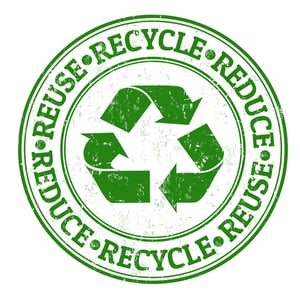Laboratory waste management can mean complicated challenges that often require multiple solutions to ensure your system runs effectively and efficiently. Yet with a few tweaks in your journey, you can improve how your lab’s waste is managed, from the moment the waste is generated to the moment it is disposed of.
How can you improve your laboratory waste management? By doing 3 things:
- Minimizing waste
- Ensuring your Hazardous Materials Business Plan is updated
- Working with an experienced lab waste management company
1. Minimize Waste
 Minimizing the amount of waste produced in your laboratory can help you get a better handle on your waste management while promoting safer working conditions. After all, less waste can lead to safer laboratory conditions by reducing how often lab workers are exposed to potentially toxic chemicals.
Minimizing the amount of waste produced in your laboratory can help you get a better handle on your waste management while promoting safer working conditions. After all, less waste can lead to safer laboratory conditions by reducing how often lab workers are exposed to potentially toxic chemicals.
Minimizing waste can also reduce disposal costs since less waste is handled and transported.
But how do laboratories minimize the amount of waste they produce?
- Keep up-to-date chemical inventories. Thorough record keeping can ensure you order the smallest quantities required for your application and allow you to minimize how much waste is stored (and eventually disposed of) onsite. Up-to-date chemical inventories can also assist you with staying organized so that certain materials can be reused, if applicable.
- Substitute hazardous wastes when possible. Although this may not minimize your total lab waste, it can help reduce the amount of hazardous waste your lab generates and must dispose of. Depending on the test, experiment or the chemical’s purpose, less hazardous materials can be substituted for common hazardous wastes. For example, biodegradable detergents like Alconox can be used instead of ethanol-base baths. In some circumstances, alcohols can be substituted for benzene.
- Reduce how many red bag containers you keep. Red bags are found throughout most laboratories, especially those where medical waste disposal is common. At the end of the day, it's a common procedure to remove these bags. However, if you have several bags located throughout the lab and therefore are not filling the containers fully, you’re likely wasting money on purchasing bags and increasing the amount of plastic waste you produce each day.
- Re-evaluate what chemicals can be recycled. If you are currently disposing of chemicals that are easy to recycle, you are missing a great opportunity to improve how your laboratory waste is managed. Certain chemicals like ethyl alcohol, xylene and formalin can be recycled, distilled or filtered. This can save you money in the long run, as well as prevent chemical waste from being a part of your waste stream.
- Institute procedural changes. Sometimes the smallest change can have a significant impact on how your company manages its waste. For example, simple procedural changes include scaling down the size of experiments, only keeping materials for the tests you perform on hand, or purchasing lecture bottles that hold specialty gases from companies that will accept their return when their contents have been fully used.
2. Ensure Your Hazardous Materials Business Plan Is Updated
If your business operates a laboratory and under California law must have a Hazardous Materials Business Plan (HMBP), it is important to ensure your plan is regularly updated.
The HMBP is an important document that contains information about hazardous materials used on site at a facility. In California, some companies are required to create this type of business plan, depending on the amount or type of hazardous waste on the facility’s premises.
The purpose of this business plan is to provide important information about hazardous materials onsite to first responders when there is a threat to public health and the environment. It also satisfies federal and state Community Right-to-Know Act laws that require industries to report on the storage and use of hazardous materials.
It is important to know, first, whether your laboratory is required to complete a HMBP. In California, you must have this plan if your lab handles these amounts of hazardous materials over the course of a year:
 55 gallons in liquid form
55 gallons in liquid form- 500 pounds in solid form
- 200 cubic feet of compressed gas
If your lab also handles materials that are considered to be “extremely hazardous substances” under Section 355.61 of Title 40 of the Code of Federal Regulations, it must also create a HMBP.
There are two important notes to keep in mind:
- Some counties in California have stricter requirements, so it is important to know what local codes you must follow as well.
- If the scope of the work your lab conducts changes, whereas before you may not have been required to have a HMBP, you may be required now.
Whether you are required to have a Hazardous Materials Business Plan or not, it is always important to make sure you have pertinent health and safety information on hand. This includes items like Material Safety Data Sheets (MSDS) for each chemical you use, information on how to contact hazmat emergency response teams and contingency plans should an emergency occur.
3. Work With An Experienced Lab Waste Management Company
Choosing a company that has experience in safely disposing of laboratory waste is critical, especially because lab waste can come from a variety of sources, from hospitals to research facilities, private laboratories and other healthcare facilities. Waste can also range from hazardous to non hazardous, making it difficult to distinguish what should go where.
Selecting a vendor isn’t as simple as randomly picking one you find online, however. Careful consideration must be given to the vendor you choose, since ultimately, you are the one who is responsible for meeting any cradle to grave requirements. In other words, you are responsible for hazardous laboratory waste from its initial generation to its final disposal, according to the Resource Conservation and Recovery Act (RCRA).
So what should you look for in a laboratory waste management company? In addition to experience, look for a vendor that:
- Doesn’t take shortcuts in the name of cost savings or speed
- Identifies lab wastes through sampling and testing
- Offers prompt pickups to ensure you are not holding onto laboratory waste beyond what is allowed or is safe
- Transports the wastes to the appropriate recycling or disposal sites
- Prepares labels, manifests and other paperwork as required by state and federal regulations
- Offers to help you package your waste properly
- Offers a walk-through program that evaluates your current waste storage, emergency readiness and how hazardous waste is handled at your site
Remember, the best vendor isn’t always the least expensive one. Trading efficiency for the sake of a few bucks can have disastrous consequences, costing you more in the long run when you run into liability issues associated with improper waste disposal.
Choosing a reputable waste disposal company, on the other hand, will give you confidence that your lab waste is being handled and disposed of safely and according to the law.


Comment